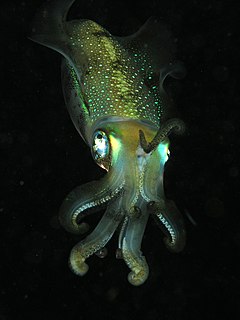
Malacology is the branch of invertebrate zoology that deals with the study of the Mollusca, the second-largest phylum of animals in terms of described species after the arthropods. Mollusks include snails and slugs, clams, octopus and squid, and numerous other kinds, many of which have shells. One division of malacology, conchology, is devoted to the study of mollusk shells. Malacology derives from Greek μαλακός, malakos, "soft"; and -λογία, -logia.

The Integrated Taxonomic Information System (ITIS) is an American partnership of federal agencies designed to provide consistent and reliable information on the taxonomy of biological species. ITIS was originally formed in 1996 as an interagency group within the US federal government, involving several US federal agencies, and has now become an international body, with Canadian and Mexican government agencies participating. The database draws from a large community of taxonomic experts. Primary content staff are housed at the Smithsonian National Museum of Natural History and IT services are provided by a US Geological Survey facility in Denver. The primary focus of ITIS is North American species, but many biological groups exist worldwide and ITIS collaborates with other agencies to increase its global coverage.

Esk is a town and locality in the Somerset Region in South East Queensland, Australia. In the 2016 census, Esk had a population of 1,698 people.
The Bioclipse project is a Java-based, open-source, visual platform for chemo- and bioinformatics based on the Eclipse Rich Client Platform (RCP). It gained scripting functionality in 2009.

Apache Taverna is an open source software tool for designing and executing workflows, initially created by the myGrid project under the name Taverna Workbench, now a project under the Apache incubator. Taverna allows users to integrate many different software components, including WSDL SOAP or REST Web services, such as those provided by the National Center for Biotechnology Information, the European Bioinformatics Institute, the DNA Databank of Japan (DDBJ), SoapLab, BioMOBY and EMBOSS. The set of available services is not finite and users can import new service descriptions into the Taverna Workbench.

Roderic Dugald Morton Page, known as Rod, is an evolutionary biologist at the University of Glasgow, Scotland, and the author of several books. As of 2015 he is professor at the University of Glasgow and was editor of the journal Systematic Biology until the end of 2007. His main interests are in phylogenetics, evolutionary biology and bioinformatics.
The National Centre for Text Mining (NaCTeM) is a publicly funded text mining (TM) centre. It was established to provide support, advice, and information on TM technologies and to disseminate information from the larger TM community, while also providing tailored services and tools in response to the requirements of the United Kingdom academic community.

The Encyclopedia of Life (EOL) is a free, online collaborative encyclopedia intended to document all of the 1.9 million living species known to science. It is compiled from existing databases and from contributions by experts and non-experts throughout the world. It aims to build one "infinitely expandable" page for each species, including video, sound, images, graphics, as well as text. In addition, the Encyclopedia incorporates content from the Biodiversity Heritage Library, which digitizes millions of pages of printed literature from the world's major natural history libraries. The project was initially backed by a US$50 million funding commitment, led by the MacArthur Foundation and the Sloan Foundation, who provided US$20 million and US$5 million, respectively. The additional US$25 million came from five cornerstone institutions—the Field Museum, Harvard University, the Marine Biological Laboratory, the Missouri Botanical Garden, and the Smithsonian Institution. The project was initially led by Jim Edwards and the development team by David Patterson. Today, participating institutions and individual donors continue to support EOL through financial contributions.

The Wellcome Genome Campus is a scientific research campus built in the grounds of Hinxton Hall, Hinxton in Cambridgeshire, England.

Europeana.eu is the EU digital platform for cultural heritage. More than 3,000 institutions across Europe have contributed to Europeana. These range from major international names like the Rijksmuseum in Amsterdam, the British Library and the Louvre to regional archives and local museums from every member of the European Union. Together, their assembled collections let users explore Europe's cultural and scientific heritage from prehistory to the modern day. Mona Lisa by Leonardo da Vinci, Girl with a Pearl Earring by Johannes Vermeer, the works of Charles Darwin and Isaac Newton and the music of Wolfgang Amadeus Mozart are some of the highlights on Europeana.
Plazi is a Swiss-based international non-profit association supporting and promoting the development of persistent and openly accessible digital bio-taxonomic literature. Plazi is maintaining a digital taxonomic literature repository to enable archiving of taxonomic treatments, enhances submitted taxonomic treatments by creating version in the XML formats TaxonX and Taxpub, and educates about the importance of maintaining open access to scientific discourse and data. It is a contributor to the evolving e-taxonomy in the field of Biodiversity Informatics.
BugGuide is a website and online community of naturalists, both amateur and professional, who share observations of insects, spiders, and other related creatures. The website consists of informational guide pages and many thousands of photographs of arthropods from the United States and Canada which are used for identification and research. The non-commercial site is hosted by the Iowa State University Department of Entomology. BugGuide was conceived by photographer Troy Bartlett in 2003 and since 2006 has been maintained by Dr. John VanDyk, Adjunct Assistant Professor of Entomology and Senior Systems Analyst at Iowa State University. The website has been recognized for helping change public perception of insects.
The Journal of Hymenoptera Research is a peer-reviewed scientific journal covering systematics, taxonomy, and ecology of Hymenoptera. It was established in 1992, and transferred to publishing with Pensoft Publishers in 2011, under an open access system. According to the Journal Citation Reports, the journal has a 2013 impact factor of 0.966.

Heritage Microfilm, Inc. is a preservation microfilm and microfilm digitization business located in Cedar Rapids, Iowa.

iNaturalist is a citizen science project and online social network of naturalists, citizen scientists, and biologists built on the concept of mapping and sharing observations of biodiversity across the globe. iNaturalist may be accessed via its website or from its mobile applications. Observations recorded with iNaturalist provide valuable open data to scientific research projects, conservation agencies, other organizations, and the public. The project has been called "a standard-bearer for natural history mobile applications."
Pensoft Publishers are a publisher of scientific literature based in Sofia, Bulgaria. Pensoft was founded in 1994, by two academics: Lyubomir Penev and Sergei Golovatch. It has published nearly 1000 academic and professional books and currently publishes 24 peer-reviewed open access scientific journals including ZooKeys, PhytoKeys, Check List, Comparative Cytogenetics, Journal of Hymenoptera Research, Deutsche Entomologische Zeitschrift, and Zoosystematics and Evolution.
Catherine Norton was an American librarian. She was the first Director of Information Systems at the Marine Biological Laboratory (MBL).

Nomenclator Zoologicus is one of the major compendia in the field of zoological nomenclature, compiled by Sheffield Airey Neave and his successors and published in 9 volumes over the period 1939–1994, under the auspices of the Zoological Society of London; a tenth, electronic-only volume was also produced before the project ceased. It contains over 340,000 published name instances with their authorities and details of their original publication, certain nomenclatural notes and cross references, and an indication of the taxonomic group to which each is assigned. An electronic (digitised) version of volumes 1-10 was released online by the uBio project, based at the Marine Biological Laboratory, Woods Hole, in 2004–2005.












